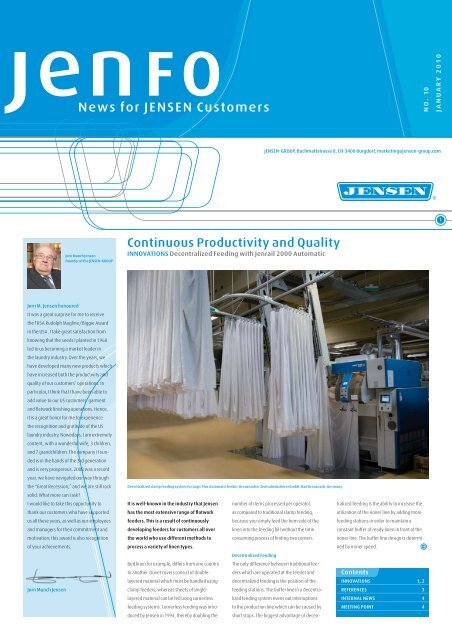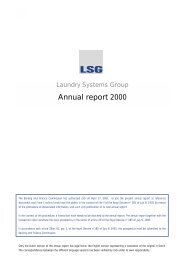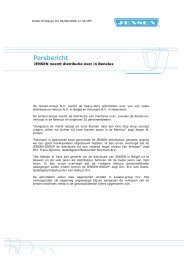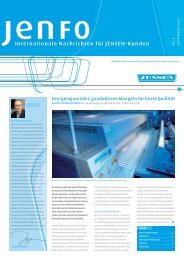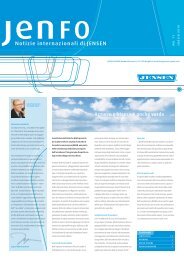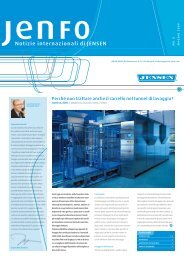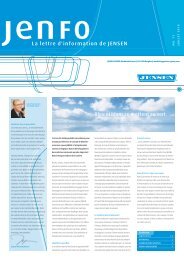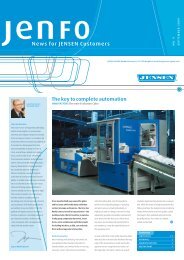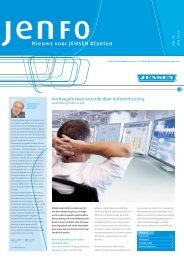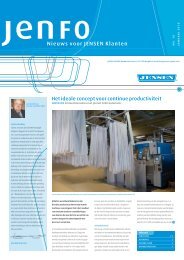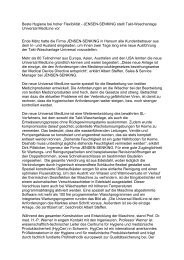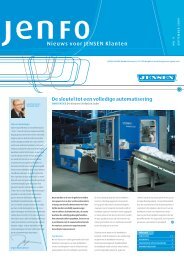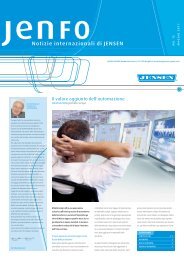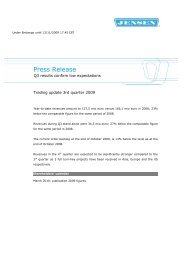News for JENSEN Customers - Jensen Group
News for JENSEN Customers - Jensen Group
News for JENSEN Customers - Jensen Group
You also want an ePaper? Increase the reach of your titles
YUMPU automatically turns print PDFs into web optimized ePapers that Google loves.
<strong>News</strong> <strong>for</strong> <strong>JENSEN</strong> <strong>Customers</strong><br />
Jørn Munch <strong>Jensen</strong><br />
founder of the <strong>JENSEN</strong>-GrOuP<br />
Jørn M. <strong>Jensen</strong> honoured<br />
It was a great surprise <strong>for</strong> me to receive<br />
the TRSA Rudolph Magline/Biggie Award<br />
in the USA. I take great satisfaction from<br />
knowing that the seeds I planted in 1960<br />
led to us becoming a market leader in<br />
the laundry industry. Over the years, we<br />
have developed many new products which<br />
have increased both the productivity and<br />
quality of our customers’ operations. In<br />
particular, I think that I have been able to<br />
add value to our US customers’ garment<br />
and flatwork finishing operations. Hence,<br />
it is a great honor <strong>for</strong> me to experience<br />
the recognition and gratitude of the US<br />
laundry industry. Nowadays, I am extremely<br />
content, with a wonderful wife, 3 children,<br />
and 7 grandchildren. The company I founded<br />
is in the hands of the 3rd generation<br />
and is very prosperous. 2008 was a record<br />
year, we have navigated our way through<br />
the "Great Recession,” and we are still rock<br />
solid. What more can I ask?<br />
I would like to take this opportunity to<br />
thank our customers who have supported<br />
us all these years, as well as our employees<br />
and managers <strong>for</strong> their commitment and<br />
motivation; this award is also recognition<br />
of your achievements.<br />
Jørn Munch <strong>Jensen</strong><br />
Continuous Productivity and Quality<br />
INNOVaTIONS Decentralized feeding with Jenrail 2000 automatic<br />
Decentralized clamp feeding system <strong>for</strong> logic Plus automatic feeder, Kreuznacher Zentralwäscherei GmbH, Bad Kreuznach, Germany.<br />
It is well-known in the industry that <strong>Jensen</strong><br />
has the most extensive range of flatwork<br />
feeders. This is a result of continuously<br />
developing feeders <strong>for</strong> customers all over<br />
the world who use different methods to<br />
process a variety of linen types.<br />
Bed linen <strong>for</strong> example, differs from one country<br />
to another. Duvet covers consist of doublelayered<br />
material which must be handled using<br />
clamp feeders, whereas sheets of singlelayered<br />
material can be fed using cornerless<br />
feeding systems. Cornerless feeding was introduced<br />
by <strong>Jensen</strong> in 1994, thereby doubling the<br />
N O. 10<br />
<strong>JENSEN</strong>-GrOuP, Buchmattstrasse 8, CH-3400 Burgdorf, marketing@jensen-group.com<br />
number of items processed per operator,<br />
as compared to traditional clamp feeding,<br />
because you simply feed the hem side of the<br />
linen into the feeding bill without the time<br />
consuming process of finding two corners.<br />
Decentralized feeding<br />
The only difference between traditional feeders<br />
which are operated at the feeder and<br />
decentralized feeding is the position of the<br />
feeding stations. The buffer line in a decentralized<br />
feeding system evens out interruptions<br />
to the production line which can be caused by<br />
short stops. The biggest advantage of decen-<br />
tralized feeding is the ability to increase the<br />
utilization of the ironer line by adding more<br />
feeding stations in order to maintain a<br />
constant buffer of ready linen in front of the<br />
ironer line. The buffer line design is determined<br />
by ironer speed.<br />
Contents<br />
INNOVaTIONS 1, 2<br />
rEfErENCES 3<br />
INTErNal NEwS 4<br />
MEETING POINT 4<br />
JaNuary 2010<br />
1
2<br />
An operator can usually feed 250–300 items<br />
per hour at a clamp feeding station, whereas<br />
an operator on a cornerless feeding station is<br />
able to feed 400–500 items per hour. So the<br />
key issue is to decide the number of feeding<br />
stations, which should in turn correspond<br />
to the desired output of the ironer line.<br />
why Decentralized feeding?<br />
There are three major advantages to<br />
decentralized feeding in comparison to<br />
direct feeding:<br />
• Utilization of the ironer line is improved<br />
by 25–50% by increasing the number of<br />
feeding stations proportionally<br />
• Average production is increased by another<br />
5–10% by means of a buffer between the<br />
operator and the feeder<br />
• It is possible to sort different types and<br />
sizes of clean linen when soil sorting is not<br />
permitted<br />
1. loading into single clamps<br />
2. loading into tandem clamps<br />
3. Cornerless feeding<br />
However, decentralized feeding doesn’t<br />
increase the number of items processed per<br />
operator hour by 25–30% as is sometimes<br />
incorrectly assumed. The only way to increase<br />
the number of items processed per operator is<br />
to find a faster feeding method.<br />
Cornerless feeding increases the number of<br />
items processed per operator by 50% to 100%<br />
compared to clamp feeding. On average,<br />
the decentralized feeding concept increases<br />
average production by another 5–10% thanks<br />
to the buffer line. There<strong>for</strong>e, if you want to<br />
increase capacity by 25% or more compared to<br />
traditional feeding, it is not sufficient to simply<br />
add a buffer line. Either the number of feeding<br />
stations should be increased proportionally or<br />
the feeding method should be changed from<br />
clamp feeding to cornerless feeding. Naturally,<br />
be<strong>for</strong>e increasing the capacity, you should<br />
ensure that the ironer and the folder can cope<br />
Example layout: Decentralized feeding system<br />
with two buffer lines <strong>for</strong> sorting:<br />
A<br />
B<br />
C<br />
D<br />
E<br />
D<br />
A<br />
B B<br />
B<br />
Delivery conveyor<br />
loading stations<br />
Buffer lines <strong>for</strong> 2 sortings<br />
Deloading stations<br />
logic Plus automatic feeder<br />
E<br />
D<br />
C C<br />
with this increase while still providing a sufficient<br />
level of quality. Decentralized feeding<br />
doesn’t automatically increase the finishing<br />
quality as this is a result of the feeders’ ability<br />
to feed the linen into the ironer correctly. It is<br />
also essential that the correct feeder is combined<br />
with the decentralized feeding system.<br />
This is why <strong>Jensen</strong> designed the Jenrail 2000<br />
Automatic which can be combined with different<br />
types of <strong>JENSEN</strong> feeders in order to satisfy<br />
two crucial requirements:<br />
• cornerless feeding <strong>for</strong> high capacity feeding<br />
of sheets using the Quick Automatic feeder<br />
• clamp feeding <strong>for</strong> top quality feeding of duvet<br />
covers and table linen using the Logic Plus<br />
Automatic.<br />
The feed concept should be chosen according<br />
to the type of processed linen as it can have<br />
serious consequences in terms of the number<br />
of items processed per operator hour. Clamp<br />
feeding, <strong>for</strong> example, requires five or six<br />
operators to feed 1500 standard sheets per<br />
hour in single-lane operation, whereas three<br />
operators can easily feed 1500 items per hour<br />
into cornerless feeding stations, which may be<br />
the limit of your ironing capacity depending on<br />
steam pressure/temperature.<br />
In some countries, manual pre-sorting of<br />
soiled linen is not permitted. In this case,<br />
post-sorting the mixed clean linen into buffer<br />
sorting lines is the only solution. This requires<br />
clamp feeding as you may need to feed duvet<br />
covers and sheets in a single ironer line.<br />
Sorting is carried out automatically according<br />
to customer and/or item. If the volume is<br />
large enough, we suggest using dedicated<br />
ironer lines <strong>for</strong> the two different purposes,<br />
high capacity or high quality. Thus, when feeding<br />
sheets the highest capacity per operator<br />
hour will be achieved, and when feeding table<br />
linen and duvet covers the highest finishing<br />
quality will be achieved.<br />
Ergonomics and High Capacity<br />
With single clamp feeding <strong>for</strong> very large<br />
items, the first clamp lifts the first corner of<br />
the linen into a height-adjustable position,<br />
thus presenting the second corner to the<br />
operator. After clipping the second corner into<br />
the second single clamp, both clamps transfer<br />
the two corners into the special tandem<br />
clamp, carrying one item of linen per clamp.<br />
This solution optimizes ergonomics <strong>for</strong> the<br />
operators and doubles buffer line capacity<br />
compared to single clamps as one tandem<br />
clamp takes up only half the space of a single<br />
clamp. Direct feeding into the unique <strong>Jensen</strong><br />
tandem clamp is recommended <strong>for</strong> feeding<br />
standard size large items as this gives a higher<br />
capacity per operator than the single clamp<br />
solution. No matter which option you choose,<br />
we have the perfect solution to meet your<br />
requirements.<br />
Two-lane Quick automatic<br />
In the hospital sector, large volumes of sheets<br />
are processed. The demand <strong>for</strong> lines dedicated<br />
purely to sheets led to the recent development<br />
of the two-lane Quick Automatic. This feeder<br />
is designed to feed 2000 items per hour with<br />
only four operators. Thus the capacity per<br />
operator doubles compared to clamp feeding.<br />
Furthermore, the ironer’s evaporation capacity<br />
is optimized.<br />
Decentralized feeding system with cornerless feeding <strong>for</strong> Quick automatic feeder, Kreuznacher Zentralwäscherei GmbH,<br />
Bad Kreuznach, Germany
N O. 10<br />
JaNuary 2010<br />
The Most laundry in China focuses on Quality and Sustainability<br />
rEfErENCES CwS-boco laundry and Hygiene Service Co. ltd., Peking, China<br />
from left to right: Thomas yin, Sales representative <strong>JENSEN</strong> China and Peter Taylor, Managing Director CwS-boco laundry<br />
and Hygiene Service Co. ltd. China.<br />
CwS-boco took full advantage of the fact<br />
that this year’s Tecxare asia exhibition<br />
was held in Beijing (October 28 to 30) and<br />
invited visitors to come and see its new<br />
laundry. More than 120 visitors, most of<br />
whom were <strong>JENSEN</strong> customers in China,<br />
accepted the invitation to attend on<br />
October 29.<br />
The new CWS-boco laundry is situated in<br />
the Logistics Park near Beijing airport. The<br />
laundry opened at the beginning of the year<br />
with a workshop spanning 5000 m2 (53820<br />
sq. ft.) CWS-boco Beijing mainly supplies<br />
hotels, including Park Hyatt, Aman Resort<br />
Summer Palace, The Maya Hotel, and Majestic<br />
Club Beijing, with fresh linen, which is<br />
mainly processed using <strong>JENSEN</strong> equipment.<br />
Seven tons of linen are processed every<br />
day, 80% of which is washed with a P50-16<br />
Senking Universal continuous batch washer;<br />
while the remaining 20% is still processed<br />
using washer extractors. Because of this CWSboco<br />
invested in a small steam generator<br />
in order to supply the washroom area with<br />
steam. Three DT 60 Senking gas dryers<br />
completely dry the terrycloth, which is<br />
equivalent to 50% of the total linen volume.<br />
Three complete ironer lines process bed and<br />
table linen, each of which is equipped with<br />
one Jenroll EXPG 1200 dual-roller gas ironer.<br />
Large sheets and duvet covers are fed into<br />
the ironer line using the Logic Plus with three<br />
feeding stations.<br />
<strong>JENSEN</strong> CleanTech in China<br />
The CWS-boco laundry was initially supplied<br />
directly with coal gas but, due to its low energy<br />
content, they quickly switched to natural gas<br />
which has a much higher energy value. 50%<br />
of the laundry’s natural gas supply is now used<br />
to generate steam <strong>for</strong> the washroom area<br />
and the other 50% is used to heat the dryers<br />
and ironers in the full-drying and finishing<br />
zone. CWS-boco has already implemented the<br />
<strong>JENSEN</strong> CleanTech concept to a large extent.<br />
The P50-16 Senking Universal continuous batch<br />
washer contains the internal heat- and water<br />
recovery system, comprising the Spiriliser<br />
and corresponding recovery tanks. Due to the<br />
steam-heated washer extractors, each of which<br />
still consumes up to 40 liters (4.9 gal) of fresh<br />
water, the washroom area consumes 0.7 kWh<br />
(1086 BTU) of energy per kg (lbs) of dry linen in<br />
order to generate steam using natural gas. The<br />
direct heated drying and finishing area, which<br />
contains the three DT 60 Senking gas dryers<br />
with RecoCross heat exchangers and three<br />
Jenroll EXPG gas ironers, uses up to 0.5 kWh<br />
(776 BTU) of energy per kg (lbs) of dry linen.<br />
Peter Taylor, Managing Director of CWS-boco<br />
Laundry and Hygiene Service Co. Ltd. in China<br />
is convinced that the current total energy<br />
consumption of 1.2 kWh/kg (1861 BTU/lbs)<br />
of dry linen can be reduced even further:<br />
“We aim to reduce the laundry’s total energy<br />
consumption to 0.9 kWh/kg (1396 BTU/lbs)<br />
of dry linen. In order to achieve this, we will<br />
further reduce energy consumption in the<br />
CwS-boco sets the standard in cleanliness <strong>for</strong> laundry rental services in China.<br />
washroom area by increasing the<br />
utilization of the P50-16 Universal washing<br />
tunnel and by lowering the total water<br />
consumption. The key factor is the reduction<br />
or elimination of steam generation, which<br />
means switching the washing tunnel energy<br />
supply from steam to gas.”<br />
CwS-boco Shanghai<br />
The headquarters of the CWS-boco Laundry<br />
and Hygiene Service Co. Ltd. is located in the<br />
Jiading district in Shanghai. Shanghai’s first<br />
and largest laundry opened in 2008 and was<br />
completely equipped with <strong>JENSEN</strong> machines<br />
from the outset. Today, CWS-boco Shanghai<br />
operates 24/7, processing 30 tons (66000 lbs)<br />
of linen with two P-50 Senking Universal<br />
continuous batch washers, two SEP 50 MD<br />
water extraction presses, Senking gas dryers,<br />
and four gas-fuelled <strong>JENSEN</strong> ironer lines.<br />
CWS-boco is fully prepared <strong>for</strong> the Shanghai<br />
EXPO 2010. At full capacity, the laundry is able<br />
to process 60 tons (132000 lbs) of flat linen<br />
and 5000 uni<strong>for</strong>ms in 24 hours.<br />
CWS-boco is the first textile services provider<br />
in China to be awarded the RAL 992 Certification<br />
by the Hohenstein Institute. The experts<br />
from the internationally renowned research<br />
institute awarded the prestigious mark of<br />
quality in recognition of the high quality<br />
and environmental standards achieved by<br />
the CWS-boco laundry facility. The laundry is<br />
equipped with the latest <strong>JENSEN</strong> technology<br />
to ensure particularly low consumption of<br />
energy and water combined with stringent<br />
quality and hygiene standards throughout the<br />
entire laundry process. For example, thanks<br />
to the integrated Spiriliser heat exchanger,<br />
energy consumption in the Senking Universal<br />
batch washer is reduced by up to 40 percent.<br />
Using the RecoCross heat exchanger in the<br />
drying process also reduces the amount of<br />
natural gas used in the Senking gas dryers<br />
by up to 40 percent. By re-using rinse water<br />
from the P50 Senking Universal continuous<br />
batch washer, it only takes six liters (0.7 gal) of<br />
fresh water to wash one kg (lbs) of linen – this<br />
represents a reduction of up to 35 liters/kg<br />
(4.2 gal/lbs) of water in comparison to most<br />
Chinese laundries. CWS-boco in Shanghai supplies<br />
clean and hygienic cotton towels, mats, and work<br />
wear to international companies including Hertz,<br />
Porsche, and Metro, as well as providing first rate<br />
laundry services to large hotels such as the<br />
Sheraton, Doubletree, and Sofitel.<br />
Kaj Andersen, Business Region Director Australasia,<br />
makes the following observation about<br />
<strong>JENSEN</strong>’s success in China: “We are now seeing<br />
those professional laundries that attach great<br />
value to cost-efficiency and stable production<br />
opting <strong>for</strong> <strong>JENSEN</strong>, and increasingly implementing<br />
the <strong>JENSEN</strong> CleanTech concept if they want<br />
to improve energy efficiency. The equipment is<br />
extremely reliable, yet still ensures great savings<br />
and top quality. As the only international manufacturer,<br />
we have our own sales and, most<br />
importantly, our own service organization in<br />
China which is managed by local employees.”<br />
3
4<br />
<strong>JENSEN</strong>-GrOuP<br />
Marketing<br />
Buchmattstrasse 8<br />
CH-3400 Burgdorf<br />
Switzerland<br />
www.jensen-group.com<br />
<strong>JENSEN</strong> GrOuP Changes Management Structure<br />
INTErNal NEwS The New <strong>JENSEN</strong> GrOuP Organization<br />
Steen Nielsen, Jan De Smet, Kaj andersen, Kathrin Scheffel, Martin rauch, Jesper <strong>Jensen</strong>, Markus Schalch, Jørn Munch<br />
<strong>Jensen</strong> (not active), Clément Silvaggio, Simon Nield, Bo rasmussen.<br />
The <strong>JENSEN</strong> GrOuP is organized into three<br />
business units and four worldwide business<br />
regions. These three business units,<br />
washroom, flatwork and Garment Technology,<br />
develop, manufacture, and supply<br />
an extensive, innovative, and competitive<br />
range of <strong>JENSEN</strong> products to our customers<br />
through our global network of 12 strategically<br />
located Sales and Service Centers<br />
(SSCs) and authorized local distributors in<br />
more than 50 countries. The <strong>JENSEN</strong> GrOuP<br />
currently has approximately 950 employees<br />
worldwide.<br />
Today’s challenging economic climate has<br />
led us to review our strategy and structure.<br />
Our "one-stop shop" strategy combined with<br />
our global presence is the key factor in our<br />
success. Yet, we can only continue to expand<br />
and successfully adapt to the changing market<br />
by maintaining our competitive edge and local<br />
presence thanks to our distributors and Sales<br />
and Service Centers.<br />
Innovation will be the key in all areas,<br />
whether it is improving production, developing<br />
new products, improving existing<br />
ones, entering new markets, or creating<br />
new service concepts. We must be ready<br />
to rise to new challenges and think outside<br />
of the box in order to continue challenging<br />
our competitors and maintaining our leading<br />
market position.<br />
The <strong>JENSEN</strong> GROUP has seen a period of<br />
exceptional growth over the last ten years,<br />
with turnover increasing from EUR 35 m to<br />
EUR 223 m in 2008. This growth was in part<br />
due to acquisitions as well as organic growth<br />
as our customer base has grown in proportion<br />
to the increased market share. However, new<br />
challenges and the competitive nature of our<br />
Executive VP<br />
Business Development<br />
Steen Nielsen<br />
Projects<br />
business must drive us to become a better<br />
company by improving our systems and processes,<br />
as well as adapting best practices in<br />
our various subsidiaries around the world.<br />
In order to meet the demands <strong>for</strong> innovation<br />
and optimization, as well as streamlining our<br />
organization, we have decided to make<br />
changes to our management structure. An<br />
Executive Management Team (EMT) was<br />
appointed to take on the following functions<br />
and responsibilities:<br />
• Jesper M. <strong>Jensen</strong> (CEO)<br />
• Markus Schalch (CFO)<br />
October 15–18, 2010<br />
Expodetergo, Milan, Italy<br />
CfO<br />
Markus Schalch<br />
<strong>Group</strong> finance, Treasury,<br />
legal, IT<br />
CEO<br />
Jesper M. <strong>Jensen</strong><br />
Executive VP<br />
Operations<br />
Martin rauch<br />
Bu washroom Technology<br />
Germany/USA<br />
Bo rasmussen<br />
Bu flatwork Technology<br />
Denmark<br />
Steen Nielsen<br />
Bu Garment Technology<br />
Switzerland/Sweden<br />
Kathrin Scheffel<br />
• Jesper M. <strong>Jensen</strong><br />
(Executive Vice President Sales)<br />
• Steen Nielsen (Executive Vice President<br />
Business Development)<br />
• Martin Rauch (Executive Vice President<br />
Operations)<br />
Exhibition schedule MEETING POINT<br />
Executive VP<br />
Sales<br />
Jesper M. <strong>Jensen</strong><br />
Business region I<br />
F, I, Mediteranian Countries<br />
Clément Silvaggio<br />
Business region II<br />
D, CH, A, UK, Scandinavia, BNLX,<br />
EE, CIS, Arab Peninsula<br />
Jan De Smet<br />
Business region III<br />
Far East, Australasia<br />
Kaj andersen<br />
Business region IV<br />
Americas<br />
Simon Nield<br />
Furthermore, we reduced the number of<br />
business regions from seven to four. We<br />
aim to fulfill all of our customer’s expectations<br />
and trust that the new Executive Management<br />
Team will enjoy the full support of all the<br />
staff and employees in the <strong>Jensen</strong> family<br />
of companies.


